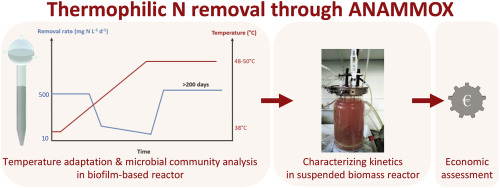Water Research ( IF 11.4 ) Pub Date : 2020-01-10 , DOI: 10.1016/j.watres.2019.115462 Tom G.L. Vandekerckhove , Ruben Props , José M. Carvajal-Arroyo , Nico Boon , Siegfried E. Vlaeminck

|
Anammox, the oxidation of ammonium with nitrite, is a key microbial process in the nitrogen cycle. Under mesophilic conditions (below 40 °C), it is widely implemented to remove nitrogen from wastewaters lacking organic carbon. Despite evidence of the presence of anammox bacteria in high-temperature environments, reports on the cultivation of thermophilic anammox bacteria are limited to a short-term experiment of 2 weeks. This study showcases the adaptation of a mesophilic inoculum to thermophilic conditions, and its characterization. First, an attached growth technology was chosen to obtain the process. In an anoxic fixed-bed biofilm bioreactor (FBBR), a slow linear temperature increase from 38 to over 48 °C (0.05–0.07 °C d−1) was imposed to the community over 220 days, after which the reactor was operated at 48 °C for over 200 days. Maximum total nitrogen removal rates reached up to 0.62 g N L−1 d−1. Given this promising performance, a suspended growth system was tested. The obtained enrichment culture served as inoculum for membrane bioreactors (MBR) operated at 50 °C, reaching a maximum total nitrogen removal rate of 1.7 g N L−1 d−1 after 35 days. The biomass in the MBR had a maximum specific anammox activity of 1.1 ± 0.1 g NH4+-N g−1 VSS d−1, and the growth rate was estimated at 0.075–0.19 d−1. The thermophilic cultures displayed nitrogen stoichiometry ratios typical for mesophilic anammox: 0.93–1.42 g N–NO2-removed g−1 N–NH4+removed and 0.16–0.35 g N–NO3-produced g−1 N–NH4+removed. Amplicon and Sanger sequencing of the 16S rRNA genes revealed a disappearance of the original “Ca. Brocadia” and “Ca. Jettenia” taxa, yielding Planctomycetes members with only 94–95% similarity to “Ca. Brocadia anammoxidans” and “Ca. B. caroliniensis”, accounting for 45% of the bacterial FBBR community. The long-term operation of thermophilic anammox reactors and snapshot views on the nitrogen stoichiometry, kinetics and microbial community open up the development path of thermophilic partial nitritation/anammox. A first economic assessment highlighted that treatment of sludge reject water from thermophilic anaerobic digestion of sewage sludge may become attractive.
中文翻译:

嗜热厌氧菌在生物反应器中的适应与表征
厌氧氨氧化,用亚硝酸盐氧化铵,是氮循环中的关键微生物过程。在中温条件下(低于40°C),广泛用于去除缺乏有机碳的废水中的氮。尽管有证据表明在高温环境下会出现厌氧细菌,但有关嗜热厌氧细菌培养的报道仅限于2周的短期实验。这项研究展示了嗜温接种物对嗜热条件的适应性及其表征。首先,选择一种附属的生长技术来获得该过程。在缺氧的固定床生物膜生物反应器(FBBR)中,线性温度从38缓慢升高至48°C以上(0.05–0.07°C d -1)在220天内施用于社区,然后将反应器在48°C下运行200天内。最大总氮去除率达到0.62g NL -1 d -1。鉴于这种令人鼓舞的性能,我们对悬挂式增长系统进行了测试。所获得的富集培养物用作在50°C下操作的膜生物反应器(MBR)的接种物,在35天后达到的最大总氮去除率为1.7 g NL -1 d -1。MBR中的生物量具有最高的厌氧氨氧化比活度,为1.1±0.1 g NH 4 + -N g -1 VSS d -1,生长速率估计为0.075-0.19 d -1。嗜热培养物显示典型的嗜温厌氧氨氧化氮的化学计量比:0.93-1.42克N-NO 2 -除去克-1 N-NH 4 +除去和0.16-0.35克N-NO 3 -产生克-1 N-NH 4 +已删除。对16S rRNA基因的扩增子和Sanger测序揭示了原始“ Ca”的消失。Brocadia”和“ Ca. Jettenia”类群,使Planctomycetes成员与“ Ca.”仅具有94–95%的相似性。厌氧性Brocadia anammoxidans”和“ Ca.B. caroliniensis”,占细菌FBBR群落的45%。嗜热厌氧氨氧化反应器的长期运行以及有关氮化学计量,动力学和微生物群落的快照视图为嗜热部分硝化/厌氧氨氧化的发展开辟了道路。一项初步的经济评估强调,处理污泥的废水经高温厌氧消化后会排斥水。











































 京公网安备 11010802027423号
京公网安备 11010802027423号